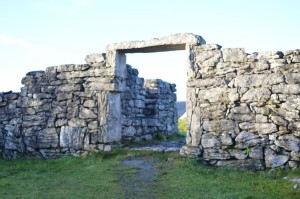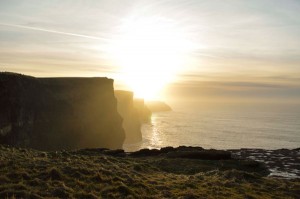Don’t worry folks; it’s craic not crack. Really it’s an Irish Gaelic word that means fun. See how happy that title is now? We learned that, amongst many, many other interesting facts while on our guided couch tour of the Burren from our chipper, knowledgeable driver and guide, Brian. We awoke early, at least for a Saturday, and made our way to gather together on the damp sidewalk outside the cottages; chattering excitedly and lined up waiting for the bus like schoolchildren on the first day of class. Zooming past the quaint houses and charming shops that make up the small village of Ballyvaughan, the tour bus took us up just a bit into the grassy hills and rocky mountains. Hardly having enough time to figure out which direction we were going, we were suddenly at our first stop. Through the vast sheets of glass that separated us on the bus from the brisk outside air we could see a large, circular mound of grassy earth that dipped down on one side and encompassed a considerably smaller flat area. They call it a Rath, and in the ancient times, the mound would contain a moat and both would help to protect a family, three to four huts, and their livestock. While these Raths are common in other parts of Ireland, they are not too often found in the Burren due to the lack of soil necessary to create them. Much more common are the structures that we went to visit on our next stop, only a few minutes down the road. They have similar circular patterns but instead of the tall masses of soil and grass they are formed with the slate grey, jagged rocks that are found all over in the Burren. This time we all got off the bus and crunched along the short dirt path to the stone fort. As we went under the blocky stone entrance to squish and slide our way across the wet grass and frosty stone we could step aboard a recently constructed lookout area, not unlike a wooden dock. From here it seemed you could see all of the Burren: the stone mountain across the way, in between was the valley stretching beneath, Ballyvaughan nestled inside it and the shimmering waters of Galway Bay off in the distance.
After a while we were herded, like the sheep in the fields around us, back onto the bus to go to our next location. As we gazed out at the stone walls, towering hills, and grazing livestock Brian would enchant us with stories and facts of the land and the sites we were to visit. He would point out interesting obstructions in the landscape, like the crumbling towers of olden castles, or the hazel brush that suffocates the fields, or the ancient tombs that dot the land. It was at one such tomb, the most visited and famous in the Burren, that we made our next stop: the Poulnabrone Portal Tomb. One of the few tombs that has been excavated, it was built sometime between 3800 and 3200 BC and marked the graves of between sixteen and twenty-two adults and six children. It is a remarkable structure. The three stones that form the parallel walls seem slender and fragile for their size. The large stone that makes up the roof is tilting as if about to slide off and come crashing to the ground. And while it has been standing for thousands of years is seems that it could all topple over like dominos with one slight breeze.
When our cheeks were rosy and our stomachs grumbling we made our way back to the bus to head off for lunch. After a stop at the Kilfenora Cathedral for some more sightseeing, a deliciously warm lunch, and a quick stop at the grocery store, we were back on the road. We had one last big stop before the sun would start to set. We arrived at the Cliffs of Mohr, with more tourists bustling around than we had seen all week. And once you catch a glimpse of the cliffs it’s no wonder why. Reaching far up to meet the sun and sky and plunging deep down to the sea, they stand bold and defiant against the angry crashing of the waves below. Beyond their jagged edges the glimmering blue waters of the Atlantic stretch as far and wide as the unending clear sky above. On our right side is a sandy stone tower perched upon a lone cliff, while on our left the setting sun kisses the tops of the cliffs that continue on for miles, and the blinding light almost dares you not to look at them. We walked, separated from the edge by a wall made out of stone slates sticking upright from the ground, as long as we dared until the frigid breeze forced us to retreat.
When our noses are glowing bright, our hair is windswept, and our fingers are too numb to click the shutters on our cameras, we again boarded the bus. On the way back, when dusk had set in and the lighting was dim, we took a short stop along the ocean to peer over the edge. While not very comparable to the Cliffs of Mohr, the sheer rock with an eighty-foot drop was enough to make most feel a bit timid. Those who felt daring would get within inches of the edge and peek over to see the swooping, raging waves below. When the wind had stung our faces and we’d had our fill of adrenaline for the day, we stepped on board the bus for the final time and slouched to sink and settle into the slick seats, not unlike the way our boots had sunken into the mucky, rain-soaked soil so many times that day. And as the sky grew steadily darker we made our way back to the Burren, back to Ballyvaughan.
After I asked my fellow trip-mates, “what was your favorite part of the tour?”
“My favorite part was the cliffs because they are extremely high and it’s cool how close you can get to the edge and how loud the waves were. I also really liked walking on the limestone and seeing how the rain forms different shapes in the stone.” – Jessica M.
“I liked standing on the edge of the ledge at our last stop and getting so close to the edge was such an adrenaline rush.” -Tram
“Having the opportunity to be so close to the portal tomb was absolutely enthralling. To be able to put our own photographic perspective on one of the most frequently photographed landmarks in the world was an absolutely amazing experience and opportunity.” – Jessie D.


